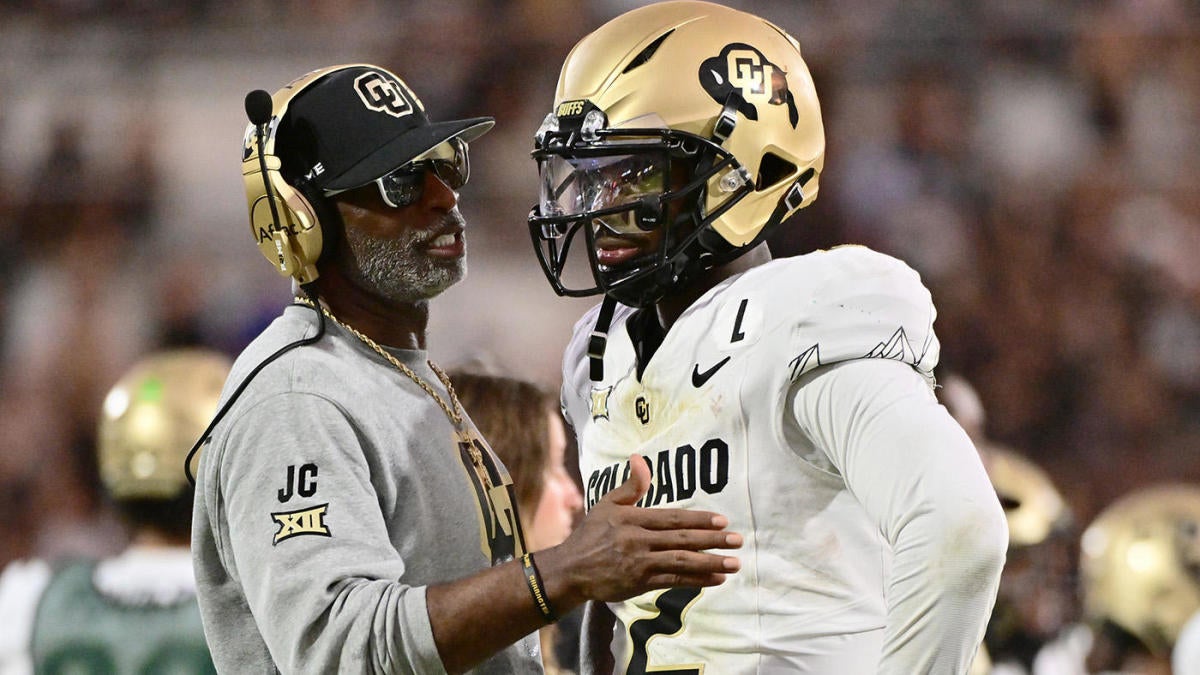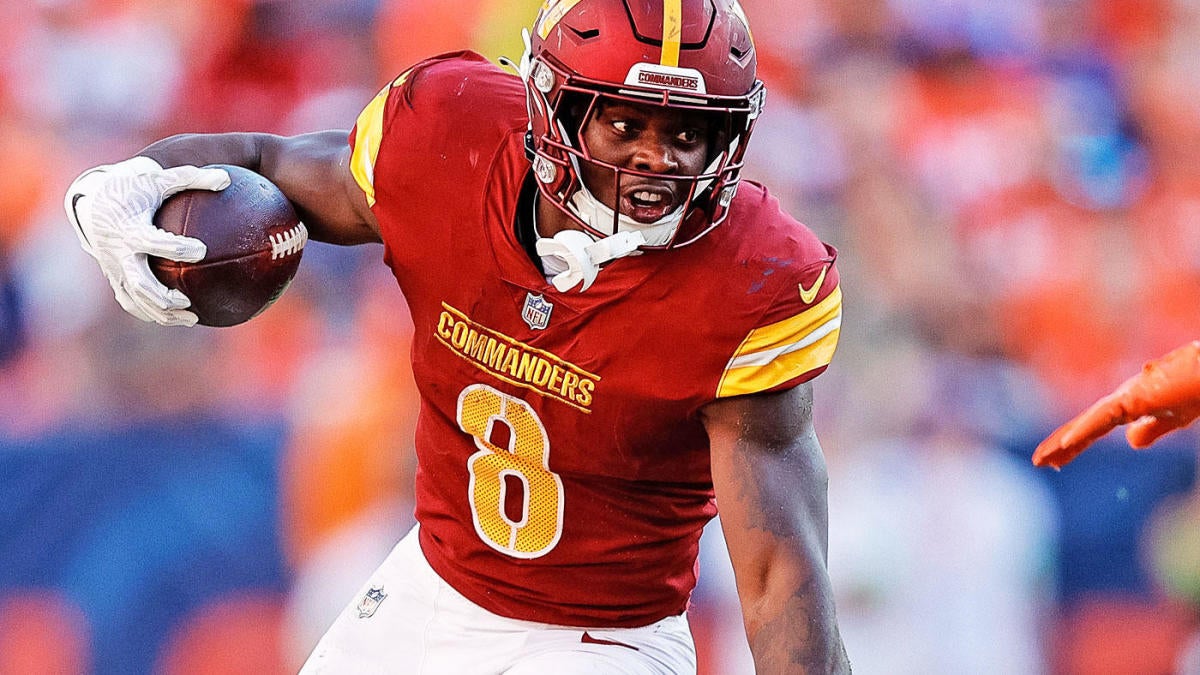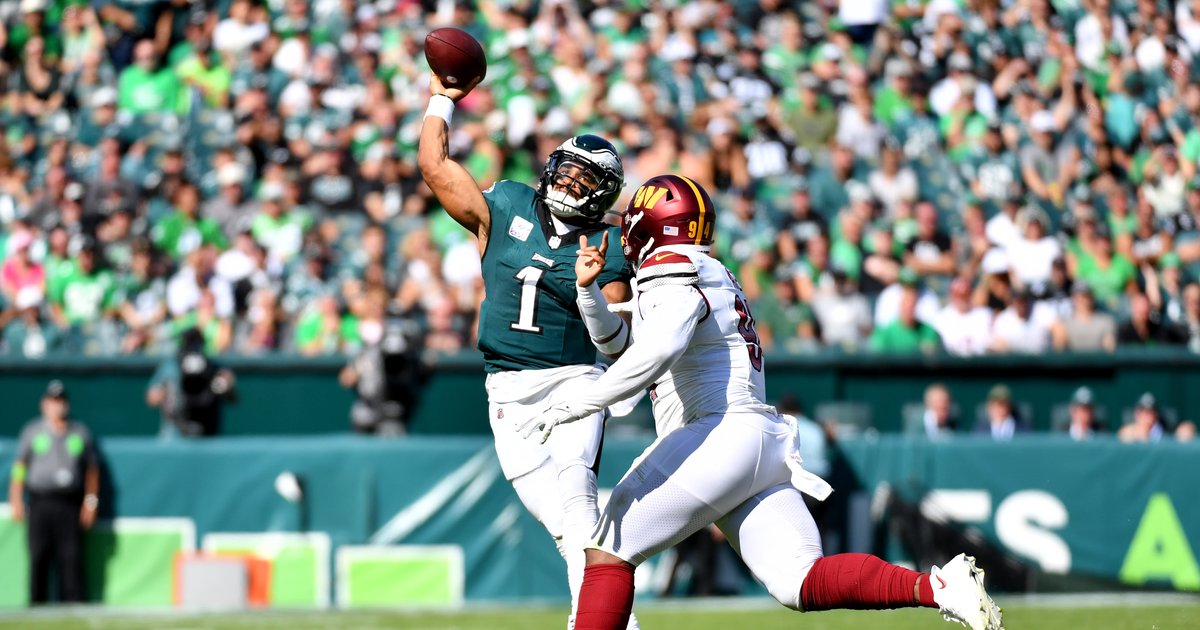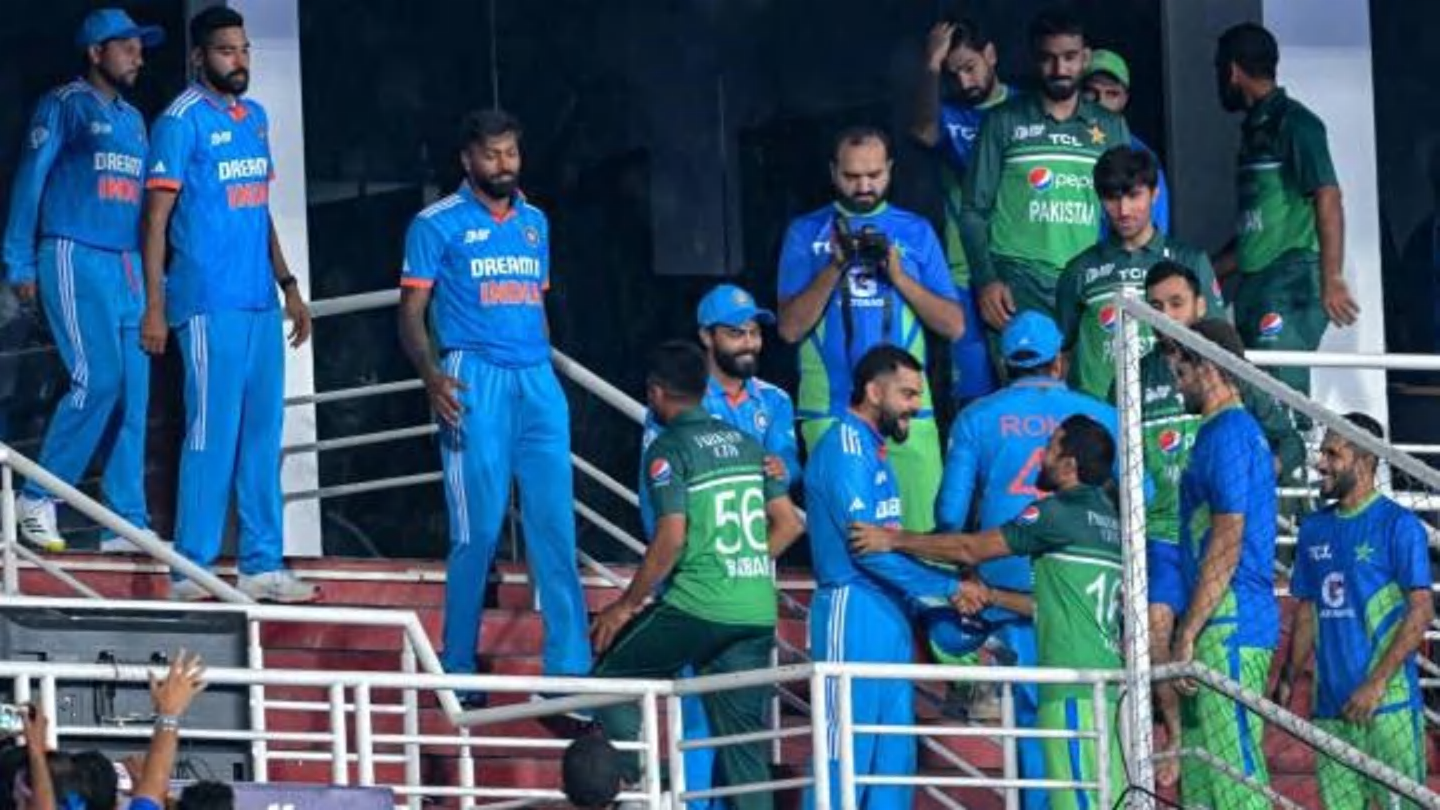The Winners and Losers of NFL Week 10

Every week this NFL season, we will break down the highs and lows—and everything in between—from the most recent slate of pro football. This week, we learned that throwing five interceptions (ahem, Jared Goff) doesn’t mean certain defeat and that, yes, the Chiefs will keep getting away with this. Welcome to Winners and Losers.
Winner: Not Having to Rely on Jared Goff
Since Week 8, Jared Goff ranks 22nd in yards per dropback, 21st in EPA per dropback, and 14th in success rate. He’s thrown a pick or fumbled the ball on 9.5 percent of his dropbacks, the worst mark in the league over that span, per TruMedia. Not great for a quarterback who now makes $53 million a year! For most teams, that would be a serious issue. But the Lions aren’t most teams. They’ve not only survived this stretch of mediocre play from Goff, but they’ve gone 3-0 while scoring the most points in the NFL over that time. In a league dominated by quarterbacks—where dominant QB play is viewed as a prerequisite to winning a championship—Detroit has managed to build an offense that can be QB-proof if it has to be.
That’s not to say the Lions can win a title if Goff is throwing picks as frequently as he did in their 26-23 win against Houston on Sunday night. Detroit will need its highly-paid quarterback to play a lot better if this team is going to get to the Super Bowl, and there’s no way to sugarcoat the five-interception stinker Goff just gave us on Sunday Night Football.
But this win does speak to the margin for error this loaded Detroit roster, built by Brad Holmes and developed by Dan Campbell, provides for its roller-coaster quarterback. The win over Houston is also illustrative of the myriad ways this team can win a football game. They can lean on their offensive line when Goff is struggling, and feel confident that David Montgomery or Jahmyr Gibbs are just a play away from generating an explosive play in the running game. When Goff is feeling it, there’s no slowing down Detroit’s play-action passing game or stopping slot receiver Amon-Ra St. Brown on third down. The defense is just as dynamic. Defensive coordinator Aaron Glenn is calling more man coverage than anyone in the league, but he also has a deep bag of matchup zone coverages and blitz designs to throw at opposing offenses as changeups if they’re sitting on his heater.
The Lions can shape-shift on both sides of the ball week-to-week. It can win a shootout, a slugfest, or any style of game in between. And it’s the one team that can compete in any game genre regardless of its quarterback’s performance.
Winner: The Chiefs’ Devil Magic
The Broncos had the NFL’s last remaining undefeated team on the ropes. Sean Payton and Bo Nix had done their job, driving Denver’s offense deep into Kansas City territory to set up a chip-shot field goal for a win over the defending champs with one second left on the clock on Sunday. The Chiefs’ 14-game win streak, which dates back to New Year’s and includes last season’s postseason run, appeared to be over. But a team doesn’t go on that long of a winning streak without some good luck, and Sunday’s game showed Kansas City’s hadn’t run out.
Chiefs outside linebacker Leo Chenal caved in the left side of Denver’s offensive line and laid out for the game-sealing block on Wil Lutz’s field goal attempt, giving the Chiefs a win they probably didn’t deserve. The Broncos averaged more expected points added per play and had a higher success rate, per TruMedia. Denver had a more efficient passing game, was more efficient on the ground, and didn’t commit a turnover. That’s typically a winning formula.
I’d say the 9-0 Chiefs can’t keep getting away with this, but we all know that’s not true. It appears Kansas City inherited all of the dark magic that sustained New England’s dynasty for decades and will ride it to countless inexplicable wins and Lombardi trophies over the next decade. I’m just warning you now.
Most of Kansas City’s “magic,” “luck,” or whatever you want to call it is simply having Patrick Mahomes. Steve Spagnuolo’s defense also deserves a sizable chunk of credit for Kansas City’s win streak. The defense keeps games close as Mahomes works around the offense’s myriad issues before ultimately winning.
The Chiefs offense hasn’t been very productive on early downs, ranking 21st in yards per play and 17th in EPA per play, per TruMedia. On third down, though, the offense morphs into the league’s best as it becomes less reliant on the run game and Reid’s play calling genius and more reliant on Mahomes’s brilliance.
Chiefs offensive rankings, early downs vs. third down
| Down | Plays | Total EPA | EPA/Play | Success Rate | Explosive Play Rate |
|---|---|---|---|---|---|
| Down | Plays | Total EPA | EPA/Play | Success Rate | Explosive Play Rate |
| First/Second | 469 | 18th | 17th | 10th | 32nd |
| Third | 125 | 1st | 2nd | 1st | 6th |
TruMedia
Sunday’s game against Denver was no different. Mahomes’s third-down magic bailed out Kansas City several times, including two conversions on third-and-13.
This is not a sustainable offensive model. Teams relying on exceptional third-down performance tend to regress toward the mean over time. The same is true for teams that never seem to lose close games. The Chiefs haven’t lost a game, but eight teams, including the Chargers in their own division, have a better point differential, and Kansas City has won just two games by more than one score this season. Everything about Kansas City’s résumé from the first half of the season screams second-half regression. But we should all know better than to count on that happening. More likely, Reid and Mahomes will eventually figure things out and get the offense back to playing championship football, and they won’t have to turn to the dark magic quite so regularly.
Loser: The Sam Darnold Revival Tour
It’s not often that a player on a winning team lands on the “loser” side here, but Darnold earned his L with a historic result. On Sunday, the Vikings became the first team since 2006 to win a game in which they committed at least three turnovers and scored zero touchdowns, escaping Jacksonville with a hard-fought 12-7 victory over the floundering Jaguars.
The fight wouldn’t have been so hard if Darnold simply protected the ball a little better. The Vikings racked up over 400 yards of offense and won the time-of-possession battle by more than 24 minutes. They dominated the game, but the quarterback did this:
And this:
And, finally, this:
All three of Darnold’s interceptions came deep in Jacksonville’s territory, and each cost Minnesota at least three points. Fortunately for the Vikings, the Jaguars could not capitalize on the mistakes—just as the Colts failed to do against Minnesota a week ago. The Vikings have now won two in a row and are just a game back from the Lions in the NFC North, but head coach Kevin O’Connell’s faith in Darnold has to be at an all-time low. That’s certainly true of the Vikings fans, who have begun calling for backup Nick Mullens and wondering whether general manager Kwesi Adofo-Mensah needs to give free agent Ryan Tannehill a call.
These are not the discussions a 7-2 team should be having, but Darnold’s play of late justifies them. He’s committed six turnovers in his last two outings and 11 over his last six games. And a lot of these interceptions have come on early downs, when quarterbacks should be more conservative with their decision-making. Only Joe Flacco and Drake Maye have a higher interception rate than Darnold on first down. If we include fumbles, no quarterback has a higher turnover rate on those plays, per TruMedia. Darnold has thrown an interception or fumbled the ball on 7.7 percent of his first-down dropbacks, which means, on average, every dozen dropbacks includes a turnover. It’s a good deal if you’re purchasing baked goods. Not so much if you’re trying to win football games.
We know that Mullens isn’t the solution to the turnover issues. Darnold may be an interception machine, but he provides the offense with a much higher ceiling, which makes up for the lower floor. Tannehill, who is currently a free agent, could be a more viable solution and has previously had success in a similar style of offense in Tennessee. He’s comfortable operating from under center in a play-action-heavy attack (which O’Connell would appreciate), and he’s not afraid to give his talented receivers a chance on 50/50 balls down the field (which Justin Jefferson would appreciate). But Tannehill, who looked washed up when we last saw him with the Titans, won’t fix the turnover issue. Pro Football Focus charged Tannehill with 11 turnover-worthy plays in nine games a season ago—that’s the same number Darnold had through his first eight starts of 2024. Darnold had a turnover-worthy play rate of 3.9 percent coming into Sunday’s game; Tannehill’s career TWP rate is 3.6 percent. In reality, Tannehill would probably be a like-for-like replacement for Darnold—just with less mobility.
The Vikings have a quarterback problem, but Tannehill won’t fix it.
Winner: Pittsburgh’s Moon-Ball Offense
The Bengals, Ravens, and Browns have signed their quarterbacks to contracts worth nearly $1 billion in combined value, but it’s the Steelers and their bargain-bin quarterback room that are leading the AFC North after 10 weeks, thanks to Russell Wilson’s three-touchdown performance in a 28-27 road win over the Commanders. Two of those scores came on Wilson’s signature “moon balls”—deep passes that sail high in the air and give the receiver plenty of time to track the ball. George Pickens, who’s been on the receiving end of several moon balls since Wilson replaced Justin Fields in the lineup last month, caught the first touchdown.
Later in the game, an errant Wilson moon ball gave Pickens the chance to maul an unsuspecting cornerback. The scrappy Steelers receiver, who once threw an opposing player into a wall by the face mask, did not pass up on the opportunity to deliver a hit.
Wilson’s second moon-ball touchdown, which proved to be the game-winner, was hauled in by the newest addition to the Steelers receiving corps, Mike Williams, who arrived in Pittsburgh following a trade from the New York Jets earlier in the week.
Plenty of people questioned Mike Tomlin’s decision to bench Fields for Wilson. Pittsburgh was sitting at 4-2 at the time and coming off of a 19-point win over the Raiders. Fields wasn’t filling up the box score, but he was making strides as a pocket passer, and, at age 25, he was a more promising long-term option for a franchise that has been in the quarterback market since Ben Roethlisberger retired. Rolling with a veteran option like Wilson is not typically seen as risky, but for Tomlin, it was. And that risk has paid off. The Steelers are scoring 30 points a game since the quarterback change, Wilson is playing his best football in years, and Pickens, who was kind of benched in early October, is thriving thanks to his quarterback’s unique deep throwing style.
Pittsburgh is making a case for why giving the young quarterback reps isn’t always the best option. (Check out what’s going on in Indianapolis with Anthony Richardson and Joe Flacco for the counterexample.) Pittsburgh’s offensive coordinator, Arthur Smith, deserves credit for bringing the best out of Wilson and this passing game. Smith has essentially built the entire thing out of Wilson’s moon-ball throws to the perimeter. Outside of those shots, the Steelers haven’t had much of a deep passing game. Wilson has been avoiding the middle of the field like it’s made of lava, as these passing charts illustrate.
That’s been a feature of Wilson-led offenses since his days in Seattle. When his teams have had a productive run game, it hasn’t been an issue. The threat of the run keeps a safety in the box, creating one-on-one passing opportunities on the outside. With the right quarterback and receivers, which Pittsburgh now has, the vertical moon balls can sustain an offense.
Wilson is making the requisite throws, and he’s on pace for his best season by EPA since 2015—which may have been the best season of his career. He’s also on pace for the second-lowest success rate of his career, which shows how boom-or-bust Pittsburgh’s passing game still is.
Through three games, there have been plenty of booms, and the busts haven’t been too big. Wilson has thrown just one interception, a third-down arm punt in the win over Washington. He’s fumbled just once, and he’s taken only eight sacks. He’s basically playing mistake-free football—he’s playing winning football—which Tomlin surely appreciates.
Loser: Caleb Williams
Of the six quarterbacks drafted in the first round of April’s draft, Caleb Williams appeared to be walking into the best situation. That was something we all seemed to agree upon, despite Chicago’s history of offensive incompetence. This season would surely be different than all those ugly seasons that came before. The Bears used their second first-round pick on receiver Rome Odunze to fill out a receiving corps led by veterans DJ Moore and Keenan Allen. The offensive line looked solid on paper. And Williams was in good hands with Chicago’s new offensive coordinator Shane Waldron, who had overseen Geno Smith’s resurgence over the last two years in Seattle. It was considered one of the best situations for a top pick in recent history.
Fast-forward a few months, and despite Chicago’s respectable 4-5 record, the situation isn’t just worse than expected. After a 19-3 loss to New England on Sunday, it looks as if Williams is in the worst situation of any of the first-round quarterbacks currently playing. The Patriots sacked Williams nine times, putting Williams on pace to finish with the second-most sacks in a single season behind only David Carr—who serves as the cautionary tale for breaking a young quarterback’s spirit. By the end of the game, even Patriots defenders seemed to feel sorry for Williams.
The pass protection has been bad, but Williams’s star-studded receiving corps isn’t playing well, either. Odunze has shown promise at times, but he has been inconsistent, as many rookie receivers tend to be. Moore and Williams still can’t get on the same page, and it appears Moore has had some issues with effort. Allen has looked like a 32-year-old receiver who has a long track record of soft-tissue injuries. And Waldron hasn’t found answers for any of those problems. Meanwhile, Williams is exacerbating those issues by holding onto the ball too long and missing throws, but these are typical mistakes for a rookie quarterback. A good infrastructure would allow a young quarterback to work around these challenges without being punished too heavily. But Williams has been throttled by every good defense he’s faced. That’s a sign of bad coaching.
Of course, there are other signs of bad coaching in Chicago, where head coach Matt Eberflus has destroyed the goodwill he earned after a 4-2 start. It would have been 5-2 if not for a coaching disaster class from Eberflus and Waldron in the last-second loss to Washington two weeks ago. Things didn’t improve in a 29-9 loss at Arizona in Week 9, in which the Cardinals scored on a draw play before the half, and Williams was pressured by 16 different defenders.
Eberflus’s defenses have performed well (just not in end-of-half situations), but his poor game management, bad situational play, and questionable taste in offensive coordinators have canceled that out. And if he hasn’t lost the locker room yet, we’re not far off from it happening.
Moving on from Waldron could be Eberflus’s final card to play before he gets the call every head coach dreads. “We’re looking at everything from top to bottom,” Eberflus said when asked Sunday if an OC change was possible. But the embattled coach is now 0-for-2 when it comes to offensive coordinator hires. Luke Getsy, his first hire, flamed out in Chicago after two seasons and didn’t last more than nine games in Las Vegas before the Raiders fired him from the same job last week. The Bears probably shouldn’t trust Eberflus with hiring the next one—and, based on the early returns, they certainly shouldn’t trust him to oversee Williams’s development, either.
Winner: The Interim Coach Bump
If Chicago needs another reason to make a coaching change, here it is:
Over the last 10 seasons, teams with interim coaches are now 13-11 in their first game with the new coach after Saints beat Falcons 20-17. Those teams were 64-164-3 (.284) at the time they fired their coaches
— Josh Dubow (@JoshDubowAP) November 10, 2024
The interim coach bump is real, and the latest proof comes from New Orleans, where the Saints beat the rival Falcons 20-17 just days after Darren Rizzi took over for the fired Dennis Allen. Atlanta missed three field goals, which also helped New Orleans’s cause, but it had been a few weeks since the Saints looked this energized, and I’m crediting this man for making it happen.
Darren Rizzi said he clogged the toilet in the head coach’s locker room when he got to the stadium today and thought “this is going to be a crappy day.”
— Katherine Terrell (@Kat_Terrell) November 10, 2024
If you couldn’t tell from that clip, Rizzi is a career special teams coach. He’s not like those glory-hog offensive and defensive assistants with their fancy play calls. His job is to convince players on both sides of the ball to run at and through the opposition. It takes a certain mentality to compete on special teams, and it takes a certain mentality to coach that out of players. It’s no wonder the special teams coach–to–interim head coach pipeline is so strong. A team that just saw its coach get fired could always use an extra shot of juice—and this dude is ready and able to supply it.
Losers: Tennessee Titans’ Ankles
And here he is buckling the knees of former teammate Kenneth Murray with a nasty jump cut:
And on this fourth-down touchdown, Herbert made several would-be tacklers whiff on his way to the end zone:
That’s a designed run play Greg Roman used to call for Lamar Jackson in Baltimore. Herbert is not Jackson, but he is one of the more impressive athletes currently playing quarterback—he just doesn’t show it off too often. But that’s starting to change. Herbert is on pace for the second-highest scramble rate of his career after setting a career-high in 2023. He’s also up to nine designed runs on the season after just 10 last season.
Herbert throws the ball as well as any quarterback in the league. The thing that had kept him a few spots below the elite tier—Mahomes, Jackson, and Josh Allen—-was the lack of creativity in his game. Herbert too often plays like a robot, and while that keeps his sack and interception totals down, it can limit the impact he has on the game. If Herbert has been reprogrammed to play off-script more often like he did on Sunday, it’s only a matter of time before he’s recognized as one of the league’s truly elite players.
Winner: Kyler Murray
No quarterback has done a better job of rehabilitating his reputation than Kyler Murray over the past two years. Whether it was fair or not, the “homework clause” in his 2022 contract created the perception that Murray had to be forced to prepare like a franchise quarterback. The Cardinals’ lack of team success earlier in Murray’s career wasn’t helping his reputation. A torn ACL that ended his 2022 season felt like it could be the beginning of the end for the former no. 1 pick in Arizona.
But two years later, the partnership looks more promising than ever. At 6-4, the Cardinals sit atop the NFC West standings (with a win over the second-place 49ers already in hand). They dismantled the Jets in a 31-6 romp on Sunday, and Murray is playing the best football of his career.
His performance against the Jets might have been his best of the season. He completed 22-of-24 passes for 266 yards and a score. He also ran for two touchdowns, was sacked just once, and did not commit a turnover.
Kyler Murray completed 22-of-24 for 266 yards and a TD against the Jets (career-high +21.6% CPOE), including each of his last 17 passes.
The odds of Murray completing each of his last 17 passes based on the probability of each attempt:
1 in 408 (0.245%)
Powered by @awscloud pic.twitter.com/clGT9nsCTr
— Next Gen Stats (@NextGenStats) November 11, 2024
But more impressive than the numbers is how Murray is producing them. He’s never looked more comfortable in the pocket, never been this accurate, and never seemed so confident in what he’s seeing downfield. His work from a muddied pocket has been especially impressive.
I am NOT kidding when I say – these might be my 3 favorite Kyler Murray throws of his CAREER… all yesterday vs Miami
Look at this dude playing from the pocket like a grown up! Big time!! Delivering absolute dimes!! Let’s goooo @danorlovsky7 pic.twitter.com/PA5JYod29D
— Ben Fennell (@BenFennell_NFL) October 28, 2024
These aren’t the sort of throws we typically see from shorter quarterbacks, but Murray’s game has grown by leaps and bounds over the past year. And so has the Cardinals offense, which looks unstoppable over the past two months. Since Week 5, Arizona ranks in the top 10 in just about every offensive metric, including yards per play, EPA, success rate, and explosive play rate, per TruMedia. Murray is at the heart of it all. He’s getting plenty of help from his supporting cast—James Conner is still running over defenders and Marvin Harrison Jr. is living up to his predraft hype—but the Arizona run game is powered by the threat of Murray’s game-breaking speed, and the passing game wouldn’t be nearly as effective without his ability to avoid sacks and create out of structure.
Murray is also playing smart football. He’s protecting the football, taking fewer sacks, and keeping the offense on schedule with mature decisions rather than hunting big plays all the time. This new, matured version of Murray has Arizona on track for the postseason, and it’s just a matter of time before he becomes part of the MVP discussion.
Related
NFL Week 11 staff picks: Moneyline, spread, over/under predictions
Wins and losses are piling up as the NFL schedule rolls along. The vague impression of a playoff picture is starting to reveal itself. Things are heating up
Deion Sanders might break the NFL Draft: Colorado coach vows…
The NFL Draft is usually a pretty simple process: A team picks a player and then that p
Thursday Night Football odds, prediction, spread: Commanders vs. Eagles picks…
A big-time NFC East showdown on Thursday Night Football features the Philadelphia Eagle
Week 11 NFL picks
For the gambling degenerates, here are my Week 11 NFL picks. To note, the team logos indicate who I think will win the game, not cover the spread. At the end of












